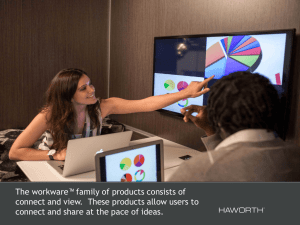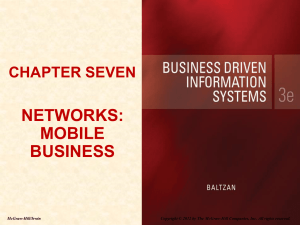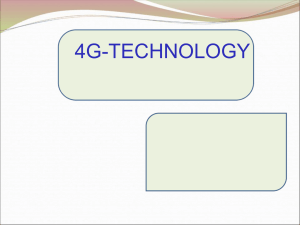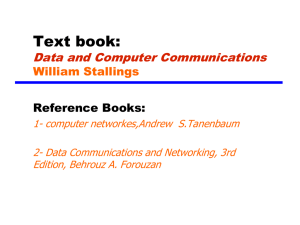Chapter 6 Business Networks & Telecommunications
advertisement
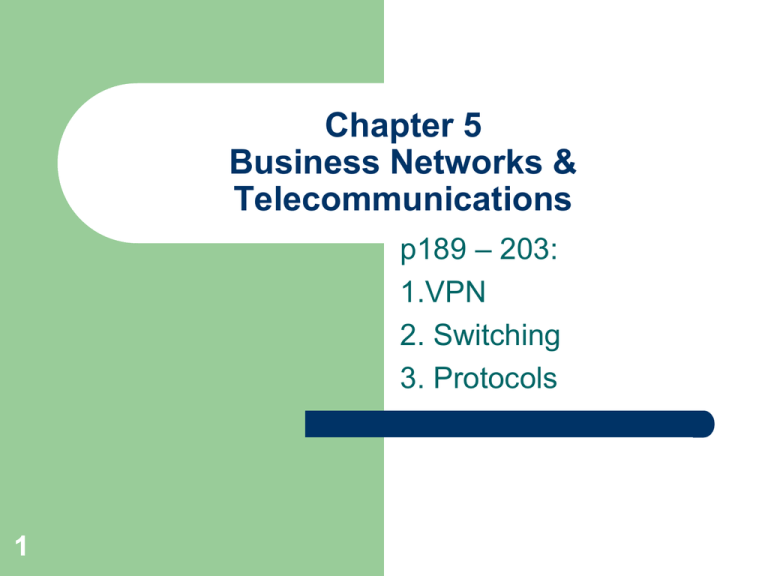
Chapter 5 Business Networks & Telecommunications p189 – 203: 1.VPN 2. Switching 3. Protocols 1 Revision: 2 What is makes up the Telecommunications Network Model? What are the two categories of media? Name the different media? What is the difference between a digital and analog signal? List the 4 different types of networks? What type of network is on slide 4? Telecommunications NW Model: 3 A telecommunications network is any arrangement where – A sender transmits a message – To a receiver – Over a channel – Consisting of some sort of medium What type of network? 4 Different Media: 5 Wired (or …….) and Wireless (…………) See next slides Telecommunications Media 6 Twisted-Pair Wire – Ordinary telephone wire – Copper wire is twisted into pairs 6-6 Telecommunications Media Coaxial Cable – 7 Sturdy copper or aluminum wire wrapped with spacers to insulate and protect it 6-7 Telecommunications Media Fiber-Optic Cable – 8 One or more hair-thin filaments of glass fiber wrapped in a protective jacket 6-8 Analog versus Digital 9 Analog or digital refers to the method used to convert information into an electrical signal – Analog: an electrical current is generated that is proportional to the quantity being observed – Digital: the quantity being observed is expressed as a number Digital Network Technologies 10 Telecommunications are being revolutionized by switch from analog to digital – Analog: voice-oriented transmission – Digital: discrete pulse transmission Benefits – Higher transmission speeds – Moves larger amounts of information – Greater economy and much lower error rates – Transmits multiple types of communications (data, voice, video) on the same circuits Virtual Private Network: 11 A network is private, when only authorized users can access the network. So instead leasing lines and services from an ISP, a company can use the internet by isolating a part of it for private use: creating a “tunnel” through the internet or any public network. This is done by implementing sophisticated security measures. See next slide. 12 13 VPN (cont.) 14 Used to establish secure intranets and extranets – The Internet is the main backbone network – Relies on network firewalls, encryption, and other security features to build a “pipe” through the Internet – Creates a private network without the high cost of a separate proprietary connection VPN (p188) 15 Intranet: Extranet: Switching Techniques How can computers or nodes link to each other on the network: – – 16 Circuit switching: dedicated channel (path or circuit) established for duration of transmission Packet switching: message broken into packets Packet: group of bits transmitted together Switching Techniques (continued) 17 Switching Tech. (cont.) Frame relay: high-speed packet-switching protocol used in WANs – – Multi-protocol label switching: enhances services like VoIP. – 18 Variable-sized packets routed quickly Better ratio of data bits to non-data bits Still broken into packages, but all will use the same path on the network Protocols 19 Protocol: set of rules governing communication between computers Protocol is like human language and basic understanding Some protocols designed for WANs, LANs, and wireless communications Most important set of protocols called TCP/IP TCP/IP 20 TCP/IP: Transmission Control Protocol/Internet Protocol – Ensures packets arrive accurately – Ensures delivery of packets from node to node, respectively Internet backbone: highest speed channels Host: computer connect directly to backbone IP number: unique identification for device DNS: Domain Name Service maintains character-based names of IP numbers What is your PC’s IP Address? 21 Start > All Programs > Accessories Command Prompt > ENTER Type: ipconfig So, what is your IP address Let’s check for GOOGLE!! 22 Still in command prompt: Type: ping google.com If you are having connectivity problems, you can use the ping command to check the destination IP address you want to reach and record the results. The ping command displays whether the destination responded and how long it took to receive a reply. Google.com 23 OPEN the browser and type in the address the ip address of google and ENTER What is the DNS service doing? TCP/IP (continued) 24 Static IP number: permanent number assigned to device Dynamic IP number: temporary IP number assigned for duration of connection IP or URL Address: The Uniform Resource Locator is an address that points to a specific resource on the Web http://www.stanford.edu/jengk/useless.html – – – – 25 http:// protocol for Web pages www.standford.edu is the Domain name: it identifies the computer that stores the Web pages Jengk/ is the directory path; identifies where the page is store on the computer Useless.html is the document name or web page Ethernet 26 Ethernet: LAN protocol using coaxial cable, also known as IEEE 802.3 Gigabit Ethernet: faster Ethernet connections Devices on network contend with other devices for transmission time CSMA/CD protocol ensures no collisions in transmission 27 28 Know more about bands: 29 See: http://www.disa.mil/jsc/speccht.html Wireless Protocols IEEE 802.11: known as Wi-Fi (wireless fidelity) – Supports wireless communication within 100 metres of router with speed of 11 Mbps: 802.11b – 802.11g Max speed 54 Mbps all in range 2.4-2.5 GHz Access point: Wi-Fi router connects to AP that connects to the Internet. Access point (hotspot): allows Internet access within range of equipment Encryption: ability to scramble and code messages – Use keys shared between sender and receiver 30 Wireless Protocol (cont.): 31 IEEE 802.15 Bluetooth: allows devices to communicate within 10 metres Examples: Wireless keyboards and mice, microphones for mobile phones. Wireless Protocols (continued) Worldwide Interoperability for Microwave Access (WIMAX): increases range and speed of wireless communication IEEE 802.16 – – Mobile Broadband Wireless Access (MBWA): similar to cell phone communications – 32 110 km, speed of 100 Mbps Works with metropolitan area networks – Compatible with IP services Compatible with Wi-Fi and Bluetooth Wireless Protocols (continued) 33 Generations in Mobile Communications Generations of mobile communication technologies are determined by capabilities and transmission speed: – – – – – – 34 1G, First generation analog and circuit switching 2G, Second generation used digital voice encoding 2.5G, Speed 144 Kbps, packet switching and limited Internet access 3G, speeds up to1 Mbps, support video, Internet access 4G, digital, packet switching, bandwidths up to 100 Mbps and tighter security. Future: Internet Networking Services 35 Variety of options to choose from when subscribing to network services Downstream: speed of receiving from network Upstream: speed of transmitting to network Cable 36 Internet links provided by television cable firms Cable connected to Internet server At residence, cable split into TV set and computer Cable shared by all subscribers Digital Subscriber Line (DSL) Digital subscriber line (DSL): data remains digital through entire transmission; 8Mbps Uses telephone lines connected to DSL bridge/modem Several types of DSL – – 37 Asymmetric (ADSL) allows different upstream and downstream rates SDSL for short distances Satellite 38 Satellite services use microwaves Service provider installs dish antenna, used as communications satellite Speeds up to 45 Mbps GPS free satellite service Fixed Wireless Fixed wireless: point-to-point transmission between two stationary devices Wireless Internet service provider (WISP) – 39 Provides fixed wireless service Highly modular and scalable Optical Carrier Optical carrier using optical fibre. – – Uses basic unit of 51.84 Mbps Used by – – – 40 Expensive High connection speeds ISPs Search engines Content-rich Web sites Broadband over Power Lines (BPL) Broadband over Power Lines (BPL): uses electric power lines to carry digital signals Used by utility companies – – – 41 Monitor power consumption Detect power failure Track power outages The Future of Networking Technologies: 42 Broadband Telephoning: VoIP Radio Frequency Identification: RFID Converging Technologies: Broadband Telephoning: 43 Voice over Internet Protocol: uses Internet connection to conduct telephone conversations using VoIP. Regular telephone companies charge according to number of minutes a call last ISP charge customers a flat monthly connection fee for connection to Internet Three different topologies: Technologies: 44 PC-to-PC PC-to-Phone Phone-to-Phone PC-to-PC: 45 In this model, both caller and receiver must have Internet phone equipment (VoIP) to talk to each other. The call is routed through an ISP such as Netcom. Both caller and receiver must have their computers on to complete calls PC-to-Phone These calls are routed like a normal telephone call, except: – 46 The PC must have Internet phone equipment A call is dialed to the ISP, routed back through the internet backbone And then sent back to the voive phone network Phone-to-Phone 47 One caller would dial a code, similar to a long-distance code The ISP gateway will rout the call through the Internet and Then converts it the signal back to the voice phone network upon reaching its connection. Advantages/Disadvantages 48 P202, 203 VoIP becomes portable Radio Frequency Identification RFID tags tiny and need little power Objects are embedded with tags that contain a transponder: – – 49 It’s a radio ‘transmitter-receiver’ that is activated for transmission by a signal that is transmitted to it The tag has a digital memory with a unique EPC RFID: The interrogator – – – 50 An Arial Transceiver Decoder Emits a signal activating the RFID tag so that the interrogator can READ/WRITE data to it Readers decode data stored in tag’s memory and data passed to host computer RFID: 51 How do companies apply this technology to the supply chain? Future Uses of RFID 52 Converging Technologies WebTV technologies allows one to add a settop box to a TV set, so that one can access also the World Wide Web: connecting to the Internet – 53 So TV technology and Web technology converges in WebTV Cell phones can act as Web phones Wireless technologies combined in same device enhance functionality Summary 54 Telecommunications is communication over distance Telecommunications technology has changed the business environment Different media have different bandwidths Networks are classified according to reach and complexity Network can be turned into a virtual private network (VPN) Summary (continued) 55 Two ways to switch a communication line: packet switching and circuit switching Network protocols are sets of rules to which all devices on network must adhere The Internet adheres to the TCP/IP protocol Wireless technologies make it easy and affordable to create wireless LANs Organizations and individuals have variety of choices when subscribing to networking services Summary (continued) 56 As Internet links become faster, Internet telephoning is gaining in popularity Wireless technologies support the increasingly popular RFID technologies Much like hardware, telecommunications technologies are merging Increasing numbers of employees now telecommute
